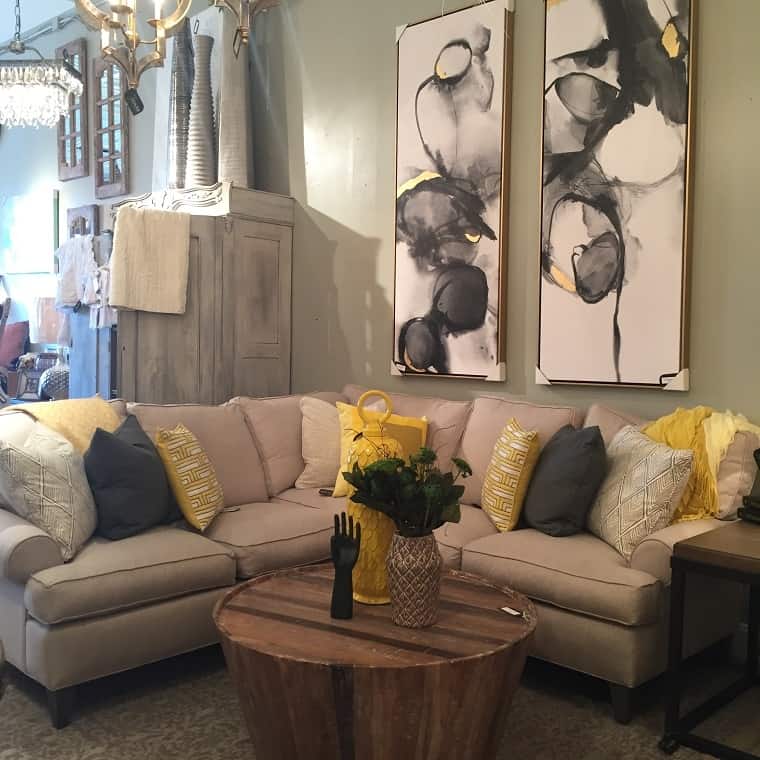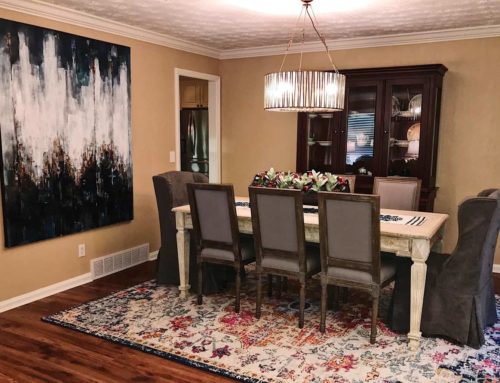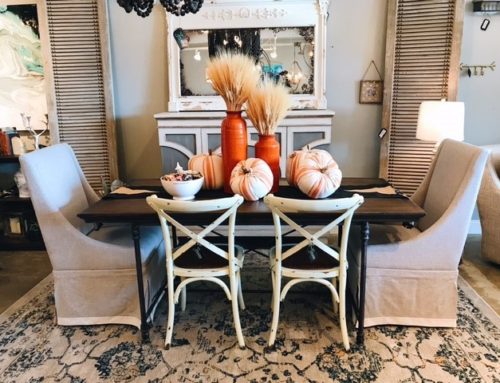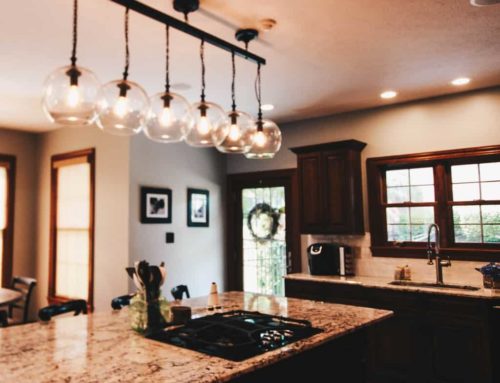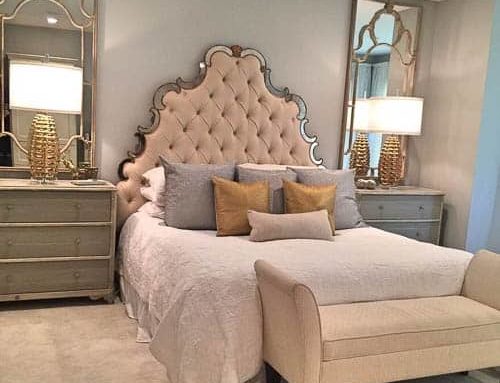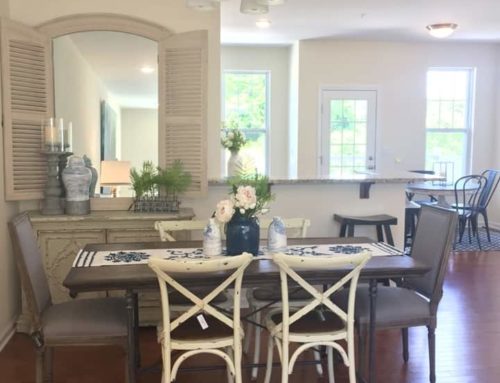By Elizabeth Yeager Cross
WV Design Team
“Don’t call it a comeback! They’ve been here for years!”
As a famous lyric once said, it’s hard to call something a comeback when they’ve never really gone. Lately, Yeager Design and Interiors has seen an increase in requests for custom sectionals.
Sofa sectionals started making their appearance on the design scene as far back as the Victorian Age, but it wasn’t really until the 1950s that they were modernized and became widely used.
As with any other product, the sectional has seen its fair share of updates throughout the decades. Companies began offering a plethora of frame styles, pieces for configuration as well as almost unlimited fabrics and finishing touches.
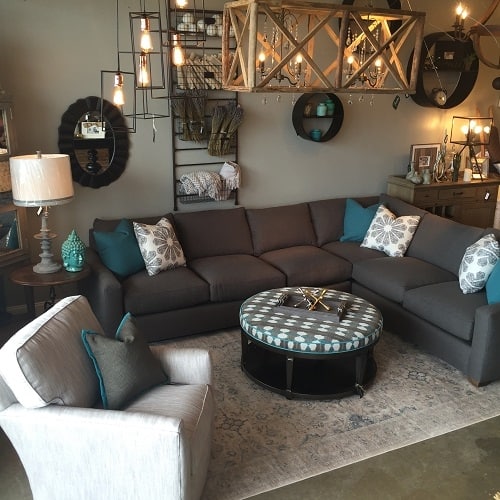
The sectional for the Lilly home needed to be soft and comfortable but stand up to everyday use and their pets. A beautiful charcoal fabric on the body of a transitional style like Brynne with pops of color and pattern make this sofa perfect for their family room
But when do you choose a sectional over a sofa? There are really three main reasons you would choose a sectional:
1. To maximize seating and comfort
2. To better fill a large space
3. To create a barrier/division in an open floor plan.
If you find your family room in constant use and feel like there’s never enough seating, a sectional may be the answer. Because of its ability to provide extra seats without wasted space, on average, two to three more people can usually find a seat on a sectional when compared to a standard-sized sofa.
Sectionals also tend to be considered for use in large spaces, especially in open-plan concepts. They can be configured to fill the void in a space and not only provide extra seating, but also act like a division wall of sorts to help uniquely separate one part of the open area from another.
Most importantly, though, how do you know the size and configuration that is right for you and your space?
Here are some things to consider.
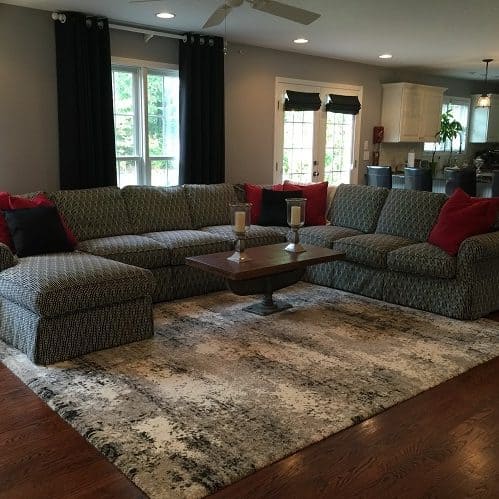
Patterns can still be neutral! This beautiful black and white sectional in the Yeager home with a queen bed insert is fun and functional. The Morgan is a classic style for a sofa and there is no classic color pairing like red, black, and white
Points of interest
What are the focal points of the space? Do you have multiple points of interest?
Perhaps you have a beautiful window view, a fireplace, a TV focal point or even a combination of the three. You will want to think of these points of reference when deciding where to start, finish and in which direction your sectional should face.
Also, while considering these focal areas, make sure you are providing adequate access between these spaces for open walkways. A good rule of thumb is to leave no less than 36 inches between any two pieces or a wall.
Other furniture
Will you be using a coffee table or ottoman?
We often find that our clients are in search of large upholstered ottomans that can be pulled close to their sectional to act as a moveable chaise lounge of sorts.
The duality in an ottoman is nice because it can serve as extra seating for entertaining, or put a tray on it to hold drinks and food.
Leave plenty of room
Be sure to leave enough room for end tables when planning the size of your sectional.
A well-placed end table can complement a larger sectional by providing a space for TV remotes and a place to set your beverages.
One pet peeve I’ve had when designing a sectional is a layout that cuts off the access to a space entirely. Try to consider giving yourself more than just one entry point to your space if possible, and if not, try making the entry point easily accessible to the closest and most logical traffic pattern in your home.
If you will be entering your room toward the back of your sectional, consider using a sofa table to pair against it, especially if you have a design that consists of multiple breaks or joining pieces, to help disguise these spots and keep the flow going.
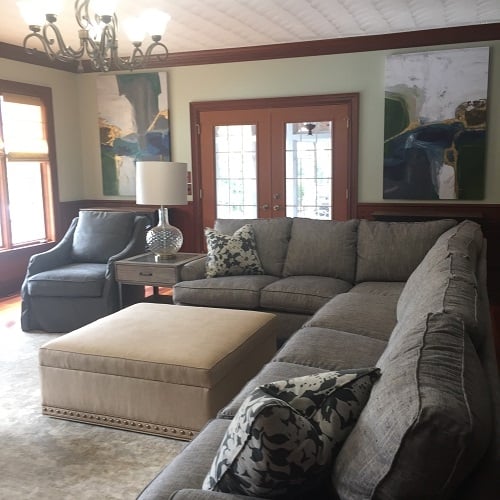
The biggest need in the Haddox family room was seating. With eight people in their family, a sectional was clearly the answer and with all of their young children, a textured fabric with blue, tan, gold, and grey thread to easily disguise wear
Configuration, style, fabric
The last things to decide are: your configuration, the style of the frame and your fabric selection.
Commonly sectionals are offered in a combination of seating options, which can vary in size and dimensions:
One, two or three seat-end with arm
Chaise lounge-end with arm
Single or double armless insert
Corner piece, square or rounded
Queen bed insert or pull-out.
These pieces determine the exact configuration of your sectional puzzle, which can come in several styles:
L-shape
U-shape
Exaggerated curve
Lengthened straight sectional with no turns
Sectional with chaise as ends
The style of your frame can help to update your selection from the sectionals of the past. By choosing a track-arm style with an exposed, detailed leg, you could easily transform your piece into a transitional seating source that won’t date your piece for years to come.
If you are more of a traditionalist at heart, a rolled arm sofa with a skirted bottom may be what makes you feel more at home. If this is the case, try choosing an updated fabric that can transcend through the styles and changes in design trends.
Fabric vs. leather
This is possibly the most questioned decision we see at YDI. While we love leather, we don’t necessarily think you have to cover all of your pieces of furniture in a room with it.
Less is more, especially in a sectional. Often a large leather sectional can seem dark, cold and foreboding.
Clients seem scared to choose fabrics due to concerns about repeated abuse from children and/or animals, when in fact, leather can be just as easily marred.
Leather can fade from the sun, show puncture holes, be scratched by claws and clothing, and usually shows the wear from the oil in peoples’ skin.
Neutral fabric selections in washable fabrics or wear-resistant fabrics, like Sunbrella, can help you keep your cushions clean while providing more warmth to your design.
Sometimes a tightly woven fabric with a few neutral colors blended together will wear better than just about anything else. By sticking with a neutral fabric for your larger sectional, you can easily change out colorful pillows, throws and accessories through the seasons and years.
For example, you may be in love with blue this year, but hold off on ordering an entire sectional in blue, because when you have tired of it, and believe me, you will, eventually, you don’t want to be stuck with such a large purchase to replace.
So if you have been on the fence about whether to take the plunge and purchase a sectional for your space, consider these details as food for thought or take it from our most recent YDI clients who are now in the “Sectional Club.”
– To see more pictures of the projects featured in this article: Haddox Home, Lilly Home,
– To read the full article: http://www.wvgazettemail.com/article

